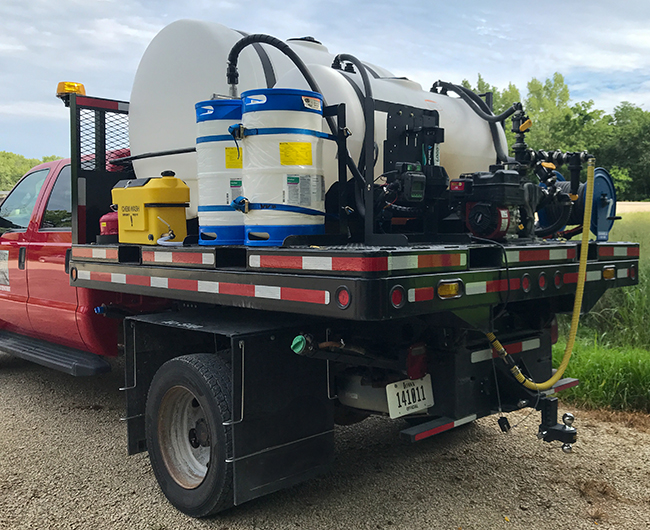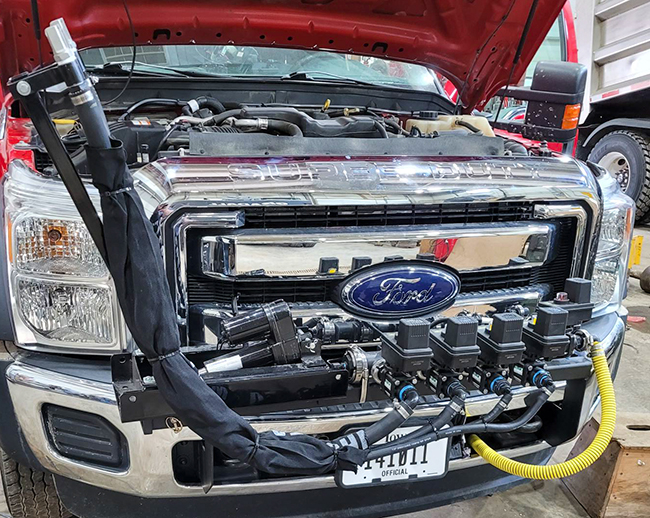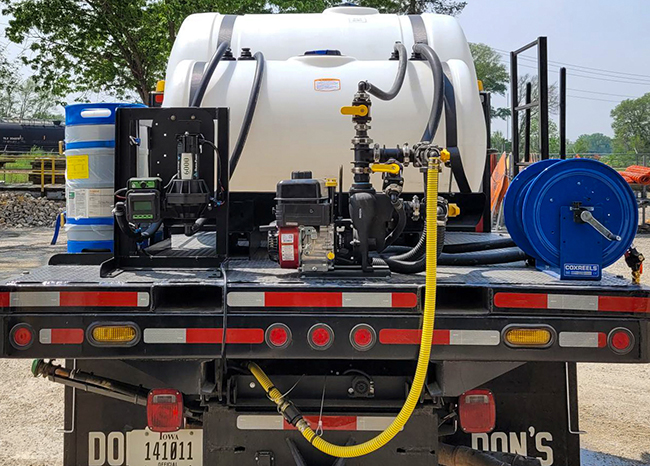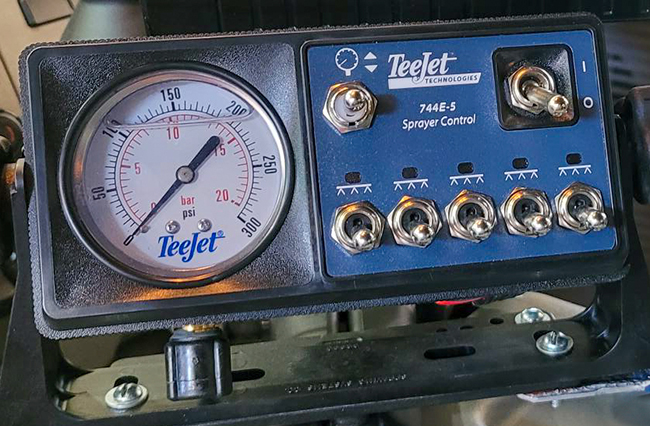Spray Systems
Table of Contents
Counties and cities typically use truck- or trailer-mounted chemical injection (high-end) or tank mix (basic) herbicide spray systems. The following is a description of one county’s two spray rigs, which are representative of the range of equipment available.
Our high-end unit is a chemical injection system. This unit has a GPS to record the rate, type, and amount of chemical used. We download that info to our desktop and print our reports. Our system has three injection pumps with three chemical tanks and a 300-gallon water tank, all on a skid for easy loading and unloading on the pickup. All the controls and the electric start are mounted in the cab on a computer stand. We have three bumper-mounted spray nozzles—6 feet, 20 feet, and 30 feet—and a hose reel with 300 feet of hose in the back. We like this unit because we can easily switch chemicals to spray something else, and one person can load and unload everything in less than an hour. A downside of this system—we can only use liquid chemicals, otherwise, everything gets plugged up.

Our basic unit can also be loaded in the truck by one person. Just about any chemical can be used because it’s a tank mix system with an agitator in the tank. It has a 200-gallon tank, also on a skid, run by a five-and-a-half horsepower motor. We have two nozzles, a 6-foot and a 30-foot on the right front bumper. There is a hose reel in the back with 200 feet of hose. There’s no GPS on this system, so we have to keep track of everything. We mounted switches in the cab to run the nozzles, but we have to get out to turn the system on and off.
Another type of truck-mounted herbicide spray system used in roadsides is invert emulsion. It was developed to reduce herbicide drift and volatilization by producing large droplets of water surrounded by oil. The droplets do not dry as fast as water, so leaf penetration is greater. Invert emulsion sprayers do not work with all types of chemical products; liquid formulations usually work best. Due to the oil used in invert emulsion, roadsides treated with this method should be monitored for phytotoxicity, which is when a chemical substance hinders the growth of plants such as perennial grasses.
Spray Nozzles
Bumper-mounted spray nozzles or raised, multi-section, nutating spray nozzles are typically used on county rigs. Here is one county roadside manager’s description of both nozzle types:
A multi-section, nutating spray head allows a mindful operator to choose which section of the ditch to spray—in two, four, or six-foot increments out to 30 feet. A system with multiple bumper-mounted nozzles can spray different distances, too, but they tend to spray everything up to that distance. The multi-section system uses less herbicide primarily by hitting a narrower band. But if operators of multi-section systems hit all seven switches every time they spray a single thistle—just to make sure they don’t miss—there won’t be much reduction in herbicide. Ultimately, a good operator still makes the difference.
Spray System Components With Options/Suggestions
Installation Method
- skid-mounted
- permanent truck or trailer
Water Tank
- 300–750 gallons (typical)
- 1,000 gallons (requires a commercial driver’s license to operate)

Chemical Mixing System
- tank-mix system with mechanical agitation (chemicals added manually to the large water tank)
- chemical injection system with 2–3 separate chemical tanks (chemicals mixed with water after passing from the tank)
Water Pump
- roller
- piston
- centrifugal
- diaphragm
Water Pump Motor
- 5.5–11 horsepower
Injection Pumps
- application of at least 20–40 gallons per minute
Hose Reel

The flatbed contains the water tank, water pump and motor, hose reel, and handheld spray gun. capable of storing a hose 200–300 feet long and ½ to ¾ inches in diameter of the threaded fitting inside the hose (electric rewind recommended)
Propellant Method
- spray gun to deliver the spray
- spray wand attached to a hose to extend the reach of the spray gun
- one-sided truck-mounted spray heads
- 2–4 bumper-mounted nozzles
- raised nutating head with multi-direction spray sections
Console

The cab-mounted console features the controller with valve switches and pressure gauge. featuring controllers, switches, GPS, computer
Controller
- with adjustable application rate
Flow Meter
- records herbicide application data
GPS
- maps spray location
- GPS units may come with additional software that is installed on a tablet or computer
Backpack Sprayers
The backpack sprayer is the best way to reduce herbicide use and target specific invasive plants, especially in diverse wildflower plantings. Consider the following tips:
- Use a low-volume backpack sprayer.
- A 4-foot wand reaches right down to the target plant.
- Herbicides made to kill broadleaf weeds will also kill wildflowers.
- Clopyralid works on tough weeds without a lot of residual effect.
- Follow the spray mixing rates on the label.
Roadside Real Talk
Insights from Roadside Managers and Other Professionals
We have an 800-gallon tank. We like using a lot of water; bigger droplets equals less drift.
Our spray rig came with an 8-horsepower engine which failed due to a mechanic’s error and was replaced with an 11-horsepower due to availability. It lasted 8 or 9 years and was replaced with a 13-horsepower, which lasted 8 or 9 years, too. We are on our second 13-horsepower HP now. Our pump is a Hypro centrifugal pump with an electric clutch. The Legacy 6000 can be used as a datalogger and rate controller. When our old datalogger died, we just piggybacked the Legacy onto our existing rate controller because it was a lot less work than redoing everything. We recommended a minimum of two chemical injection tanks, one brush and one thistle. We used to put 2,4-D in our third tank for use on large patches of various undesirable weeds—giant ragweed, hemp, crown vetch, parsnip, hemlock, etcetera. Now we put a low rate, 5 ounces per acre, of Method herbicide in the third tank and use it in addition to our brush mix when spraying honeysuckle.
—Jim Uthe and James Devig, Dallas County, 2024


